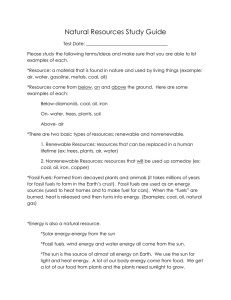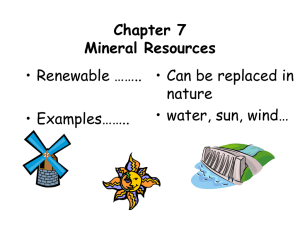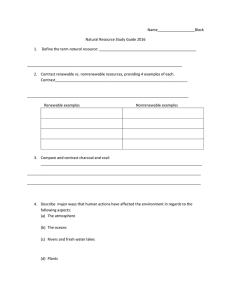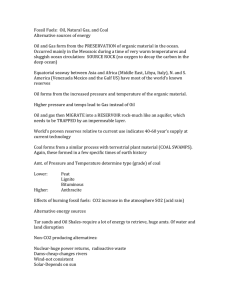Power Point notes on Renewable and Nonrenewable Resources
advertisement
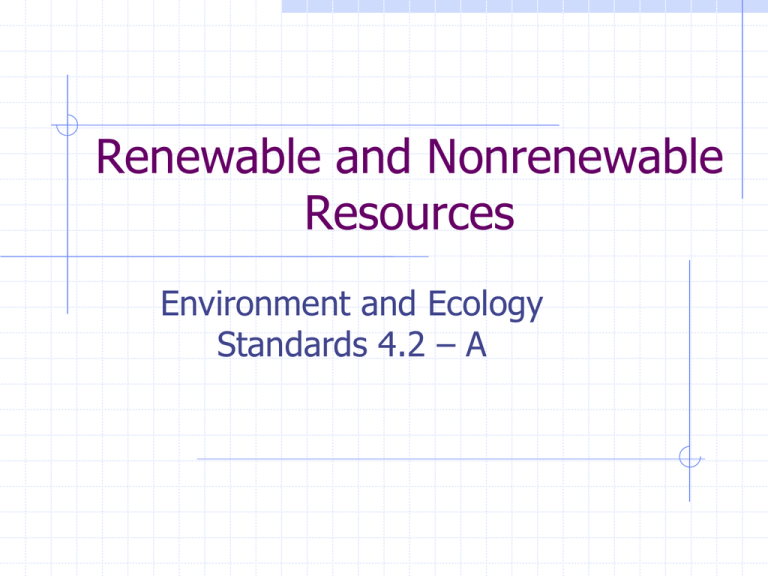
Renewable and Nonrenewable Resources Environment and Ecology Standards 4.2 – A 1. Natural Resources All of the Earth’s organisms, air, water, and soil, as well as materials such as oil, coal, and ore that are removed from the ground. Separated into two broad categories: Renewable resources Nonrenewable resources 2. Renewable Resources Are any resource that cycles or can be replaced within a human life span. Examples include: water, crops, wind, soil, sunlight, animals, etc… a. Food and fiber – are renewable agricultural resources that can be harvested or raised indefinitely… … unless their use exceeds the rate they can be replaced. b. Soil – a mixture of living organisms and dirt. Even though it initially takes thousands of years to form, the rate at which soil can regenerate depends on the climate of an area. c. Wind – caused by the uneven heating of the Earth. Not only renewable but inexhaustible. d. Sun – light from the sun supports all the life on Earth as we know it. Also considered inexhaustible. (at least for the next 5 billion years) e. Water – constantly renewed/replenished by the water cycle. However, fresh water resources are somewhat limited. The use and quality of water must be carefully monitored to ensure future use. f. Biomass fuels – are g. Geothermal energy organic matter (wood, plants, animal residues, etc…) that contain stored solar energy. Used to supply energy to 15% of the world’s supply. – the heat generated deep within the Earth. Fueled by the decay of radioactive elements. Used to heat water. 3. Nonrenewable Resources Any resource that cannot be replaced during the time of a human life span. Took thousands of years to form and exist in fixed amounts in the Earth. They need to be conserved before they become depleted. a. Ores – mineral deposits from which valuable metals and nonmetals can be recovered for profit. Metallic ores include: gold, silver, copper, aluminum, zinc, etc… Nonmetallic ores include: salt, sand, gravel, clay, diamonds, gemstones, etc.. Currently there are no metal mines in operation in PA. The major nonmetallic ores mined are coal, limestone, granite, slate, sand, and gravel. b. Fossil Fuels Are nonrenewable because they take thousands of years to form. In developing countries, the fossil fuels are fossilized wood, charcoal, and peat. In developed countries, the fossil fuels are mainly coal, natural gas, and oil. i. Coal – the remains of wetland plants that have been compressed over millions of years. Different types – Peat – about 50% carbon. The rest is water and contaminants. Lignite (brown coal) – about 70% carbon. Bituminous (soft coal) – about 85% carbon. Anthracite (hard coal) – greater than 90% carbon. This is the cleanest burning and least abundant. PEAT LIGNITE BITMUNOUS ANTHRACITE Most of the coal fields in Western PA are bituminous coal whereas the coal fields in Eastern PA are anthracite. Russia produces about 50% of the world’s supply of coal. China produces about 20%. The U.S. produces about 15% of the world’s supply. ii. Petroleum and Natural Gas – are the remains of mainly marine organisms. Typically found in underground formations called traps with the natural gas trapped on top and oil on the bottom. Currently, PA does not produce significant amounts of oil and gas but the beginning of the U.S. oil boom in the 1800’s started in Titusville, PA. 4. Global Energy Use and Production. Energy consumption increased by 50% from 1973-1993. Expected to continue to increase in the future mainly in developing or third world countries. Remember that using more fossil fuels accelerates the global warming trend due to more greenhouse emissions and pollution. What other effects will a growth in global energy use produce? 5. Alternative Energy Resources. a. These are energy resources that are more renewable or more environmentally friendly in comparison to fossil fuels. b. Currently include the following: solar, wind, geothermal, hydropower, nuclear, and biomass. i. Solar energy – can be used to heat buildings and water and provide electricity. Passive solar heating uses large south facing windows to collect the sun’s energy. Solar cells can collect and convert the sun’s energy into electricity for residential use. ii. Wind – turns giant wind turbines that produce electricity. Currently, there are about two dozen wind turbines in PA. Several are located in Somerset, PA near the turnpike. iii. Hydropower – the energy of water stored behind dams can be turned into electricity. Currently, there are 23 dams in PA that produce electricity. iv. Nuclear Power – uses the process of fission to release energy to make electricity. Produces about 20% of the electricity in the U.S. Currently, PA has five nuclear power plants.(Beaver Valley, Susquehanna, Three Mile Island, Limerick, and Peach Bottom. In 1979, there was a partial reactor meltdown at Three Mile Island. This brought a halt to nuclear development in the U.S. There have been no new plants since. Three Mile Island v. Trash – burning trash to produce electricity. Currently, PA has seven waste-to-energy plants that burn close to 19 million tons of waste a year. Availability of Resources Environment and Ecology Standards 4.2.B Almost every resource needs to be removed from the Earth and processed in some way before it can be used. What ultimately determines the availability of resources are the costs involved in removing/extracting it from the Earth and the costs involved in processing/refining them into products. 1. Removing/Extracting Earth’s Resources – Over time, technology has increased the efficiency of obtaining our natural resources. A. Farming practices – changed from many human/animal labor to increased use of farm machinery.



